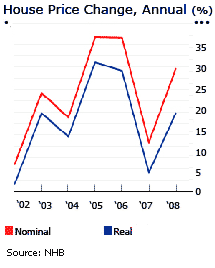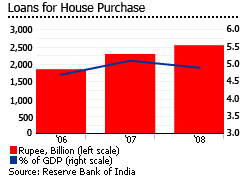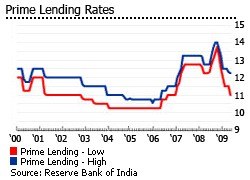Falling house prices in India

House prices in big Indian cities continued to fall during the first quarter of 2009, having begun to slide in 2008. Households are deferring purchases in anticipation of further price falls. Property developers are trying to entice buyers through price cuts and other incentives – usually to no avail.
In an April 2009 survey, a resounding 99% of residential property brokers in Delhi, Mumbai, Bangalore and Chennai agreed that prices had dropped in Q1 2009, up from 78% reporting price falls in Q4 2008, according to Edelweiss. Price falls of as much as 30% in Q4 2008 from the previous quarter were reported by Jones Lang LaSalle (JLL).
Developers face funding shortages due to the stock market crash of 2008, and fleeing foreign investors. This has led to residential project delays, and cancellations.
Indian housing statistics tend to be weak, but the National Housing Bank (NHB) now has a semi-annual residential property price index, which showed a significant slowdown in 2008 and some dramatic price declines.
- A fall in Bangalore’s house prices of 27% in 2008 (-31.2% in real terms).
In other cities the slowdown has been less dramatic:
- In Delhi, house prices increased by 4.8% during the second half of 2008. In real terms, house prices declined by 1.6%.
- Mumbai’s house prices rose 4.5% during the second half of 2008. In real terms, they fell by 2%. During the previous half year (H1 2008), prices had increased by 12% (6.7% in real terms).
Housing bubble trouble
Indian house prices rose rapidly from 2002 to 2007. Strong economic growth and urbanization supported house prices, while in city centres a housing bubble was encouraged by inadequate infrastructure, lack of planning and antiquated land use laws.
- Delhi’s residential property prices rose by 26.5% on average (21.2% in real terms) from 2003 to 2006. Price rises slowed in 2007, to 10.8% (4.2% in real terms).
- Bangalore’s residential property prices rose by 28.8% on average (23.9% in real terms) from 2002 to 2005. Price rises continued strong in 2007 at 15.1% (8.2% in real terms). Surprisingly, prices fell by 1.1% in 2006 (-6.5% in real terms).
From 2005 to 2007, the Indian economy grew annually at 8.9% per annum, making the country one of the world’s fastest growing, after 7.6% per annum growth from 2003 to 2004.
The liberalization of major sectors of the Indian economy during the early 1990s brought a rapid influx of foreign direct investment (FDI). A boom in the ICT and BPO industry generated rapid employment growth, increasing demand for housing, and caused a ripple effect in the construction and telecommunications sectors.
Yet although house price increases were supported by these strong fundamentals, speculation also played a role. From 2000 to 2006, residential property became significantly less affordable. By 2002, a residential property in Mumbai cost around 85 times the average annual average income. By 2006, residential properties in Mumbai cost 100 times the average annual income.
RESIDENTIAL PROPERTY AFFORDABILITY |
|||
| City | 2000 | 2006 | Percent Change |
| Delhi | 45.15 | 72.09 | |
| Mumbai | 84.14 | 100.02 | |
| Bangalore | 27.42 | 43.17 | |
| Sources: IMF, HDFC, Global Property Guide | |||
The capital of developers rapidly grew as their stock prices increased. Developers used the capital to bid high prices for huge plots of land, making it relatively easy to sell properties at very high prices.
Demand is falling
Since October 2008, developers have resorted to two rounds of price cuts, and have introduced lucrative deals, with subsidized furniture and internet connections. Yet buyers are unmoved. Demand remains depressed.
Demand for luxury housing has fallen 50%, while affordable housing demand has fallen 10%, according to a May 2009 survey by the Associated Chambers of Commerce and Industry of India (Assocham), the umbrella body of chambers of commerce in India,
DLF and Unitech, India’s top two developers, experienced net income declines in 2008. DLF’s net profits dropped by 41%, while Unitech saw a 28% net income decline.
Developers are refocusing on low-income houses, as the affordable housing market remains relatively strong.
Delhi: buoyed by Commonwealth Games
Delhi, the capital of India, is home to almost 18 million residents. The city will host the 2010 Commonwealth Games. Construction and improvement of infrastructure is ongoing as the city rushes to finish the facilities by the end of 2009. Other sectors benefitting from the games are SMEs, hospitality and tourism.
The average price of condominiums in New Delhi was US$2,170 per square metre (sq. m.) in Q1 2009, according to the Global Property Guide. Prices dropped in Q1 2009 due to multinational firms and non-resident Indians (NRI) holding back on purchases due to the global credit crunch, according to Colliers International.
Mumbai: highly exposed
International financial firms are cutting costs in India, because of the global financial crisis. Mumbai, with approximately 21 million residents, is India’s financial centre, and as one of the most expensive cities in the world for housing, is quite vulnerable.
The average price of condominiums in South Mumbai was US$9,542 per sq. m. in Q1 2009, according to the Global Property Guide - a price normally found only in first the world’s leading cities.
The terrorist attack in November 2008 deterred some potential buyers. The Mumbai attacks lasted three days, attacking luxury hotels, transportation systems and tourist spots, and killing at least 195 people.
Many in Mumbai now expect drops in residential property prices, according to Colliers International.
Bangalore: India’s Silicon Valley hard hit
Bangalore is India’s Silicon Valley. Prices are dropping as information and communications technology (ICT) and business process outsourcing (BPO) firms affected by the global financial crisis cut operations and slow recruitment, according to Colliers International.
The headquarters of Infosys and Wipro, India’s second and third largest software companies, are in Bangalore. A huge biotechnology sector is also found in the city.
Condominiums in Bangalore cost an average of US$745 per sq. m. in Q1 2009, according to Global Property Guide research.
Mortgage market handicapped by bad laws

Indian buyers usually pay for apartments before construction has been completed. Many buyers do not take out mortgage loans (the ratio of housing loans to GDP is less than 5% in India).
There are two main payment options.
- Lump-sum payment mode: buyers pay up to 95% of cost of the unit.
- Construction-linked payment mode: buyers pay at different stages of construction.
Despite the financial sector reforms since 1991, the expansion of the mortgage market has been held back by problems:
- Banks prefer to lend to middle and high-income sectors, leaving limited financing options for low-income individuals.
- The government has a huge influence on major domestic banks, discouraging initiative.
- There’s no proper legal framework for foreclosures
- There are rampant titling problems.
Interest rates at major banks and financial institutions range from 9% to 12% for floating rate mortgages, and 9.25% to 13.25% for fixed-rate mortgages.
The loan to value (LTV) of most Indian home loans is 85%. Recently, LTVs were reduced to 75% at LIC Housing Finance, and 80% at the Housing Finance Development Corporation (HDFC), two major housing finance institutions. Other financing institutions seem likely to follow suit if house prices continue to decline.
Yields are low in India
The most negative indicator for India’s market is that residential yields are very low. The Global Property Guide believes that, on balance, that good capital gains are much more likely in high yielding markets, than in housing markets with low yields:
- Monthly rents in Mumbai are expensive, at US$8,000 to US$11,500 per month, and yet yields are poor at 3.5% to 4.6%.
- Rents in Delhi are cheaper at US$2,000 to US$3,000 per month, but yields are also low, at 2.9% to 4%.
- Annual yields in Bangalore are relatively higher than Delhi and Mumbai, at an average of 4.6%.
The Indian rental market is hindered by problematic socialist laws protecting tenants. The laws are generally poorly conceived and ineffective, making implementation difficult. Although these laws are gradually being replaced by more market-oriented laws, the rental market’s full potential is yet to be realized.
Cities with rent controls generate lower yields. Mumbai rents in houses with sitting tenants are frozen at their 1947 levels, due to the Maharashtra Rent Act of 1999, an extension of the Bombay Rent Control Act of 1947. Delhi also has rent controls.
Sluggish construction, oversupply
The Bombay Stock Exchange (BSE) crashed in 2008, driven down by investors worried about the US recession and the global financial crisis. The real estate sector was one of the biggest losers. At one stage the BSE Realty Index was 75% down on its January 2008 peak.
With foreign investment deserting the market, developers have been forced to turn to domestic banks to finance construction activities. Developers’ finances are strained, as some have amassed huge debts. For example, DLF’s debt stood at INR140 (US$3) billion, as of June 2009.
Many projects have been delayed or halted, despite payments from buyers.
Some buyers are demanding refunds for delayed construction. Some developers have huge inventories of unsold units. Omaxe, a major luxury residential developer, had as much as 30% of its inventory unsold in 2008.
Economy slowed by crisis

In 2008 the economy slowed due to the global financial crisis, growing 7.3%. The IMF forecasts 5.4% GDP growth in 2009. Unemployment is expected to worsen, especially in the IT, finance and SME industries.
In February 2009, Edelweiss forecast that the real estate sector would remain depressed over the next four years, and predicted that prices would decline by at least 30%.